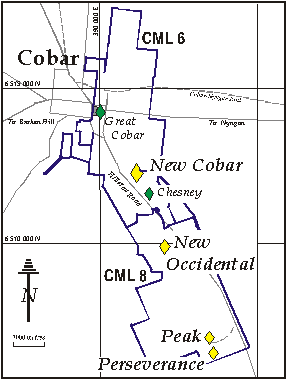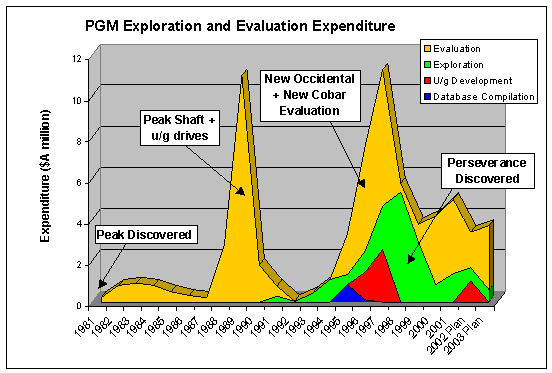Craig Stegman
Peak Gold Mines Pty Ltd, Cobar, NSW 2038.
Key Words: Cobar, exploration, gold, copper
Peak Gold Mines Pty Limited (PGM), a wholly owned business unit of Rio Tinto Ltd, undertakes gold – base metal mining within the Cobar Goldfield in western New South Wales. Its operations include the underground Peak Mine, at which reserves are largely exhausted; the newly opened underground New Occidental Mine and New Cobar Opencut; and development of a new underground mine at Perseverance. Those operations are located over an eight-kilometre strike length of the Cobar Goldfield (Figure 1). Total gold production from the Goldfield is in excess of 2.5 million ounces of gold and 140,000 tonnes of copper since mining commenced 132 years ago, making it one of the largest goldfields in NSW. PGM’s reserves at current production rates sustain operations through until at least early 2008.
Rio Tinto Group companies began exploring in the Cobar Goldfield in the early 1940’s when The Zinc Corporation formed an exploration joint venture with New Occidental Gold Mines NL. Since then, Rio Tinto’s exploration efforts have waxed and waned in sympathy with the fortunes of its various mining operations in western New South Wales, reaching a peak when its then subsidiary Cobar Mines Pty Ltd discovered the Peak deposit in 1981. Since 1987, when the commitment to mine the Peak deposit was made, Group companies have more or less been continuously exploring the Cobar Goldfield. Initially, CRA Exploration Pty Limited (CRAE) and Cobar Mines Pty Ltd (CMPL) undertook exploration in partnership, but since 1995, Peak Gold Mines (PGM) has been the sole explorer in the Goldfield. Exploration activity culminated in a major program from 1995-1999 when replacement reserves for the Peak orebody were sought. The ultimate success of that program, which identified an additional one million ounces of resources in addition to the Peak orebody, has allowed exploration in the Cobar Goldfield to continue at a relatively steady state ever since. However, exploration expenditure is tightly tied to exploration success and is entirely reliant on profitable mining operations – exploration is funded direct out of operating cash flow from the mines.
Exploration and evaluation (E&E) expenditure since 1981 highlights the relationship between exploration expenditure, discovery and ensuing evaluation expenditure (Figure 2). Following discovery of the Peak deposit, PGM’s exploration and evaluation expenditure was focussed on evaluating the Peak deposit, which included significant expenditure on sinking the Peak shaft and constructing drill-drives for underground evaluation drilling. Not surprisingly, PGM undertook little or no exploration during that period, and even after the Peak Mine went into production, PGM did not begin actively exploring until 1993, after profitability of the mine was beyond doubt. However, CRAE and CMPL were actively exploring the remainder of the Cobar Goldfield.
PGM’s exploration activities dramatically changed from 1995 onwards when the company was given control of its own destiny – that is, find more ore or close operations in 2002. The exploration strategy was threefold:
The surge in expenditure during 1996-1997 reflected concurrent pursuit of all three activities, although expenditure on “regional exploration” was relatively modest. A key component of the early exploration was a major phase of database compilation in 1995-1996, which laid the groundwork for all ensuing E&E activity. The evaluation programs at the historical New Occidental, New Cobar and Chesney Mines paid dividends, with approximately 1Moz of gold discovered, paving the way for an extension of mine life and a further commitment to exploration. Exploration of the Peak area was initially deferred whilst the North and South Exploration Drives were constructed. The upswing in exploration expenditure in 1998-1999 reflected significant underground exploration drilling in the Peak area, and elsewhere in the Goldfield. Exploration success came relatively quickly, with four separate zones of potentially economic mineralisation discovered at the Perseverance deposit, immediately south of the Peak Mine. As a result, exploration expenditure was significantly reduced in the following years while those zones at Perseverance were evaluated. An extension to the South Exploration Drive was constructed in 2002 to facilitate exploration of the southern extensions of the Perseverance mineralisation.
In reality, although E&E expenditure has been relatively high since 1995, the bulk of the expenditure has been focussed on evaluation activities and as a consequence, much of the Cobar Goldfield remains under-explored. This is a positive, and it augurs well for future discoveries!
Peak Gold Mines’ greatest exploration assets fall into three categories:
PGM’s mine infrastructure, including shaft and hoisting system; underground workings, workshops and crusher; surface processing plant including gravity, flotation, CIP circuits; tailings disposal systems; support infrastructure like offices, stores, IT networks, housing and even the humble core yard; and a trained and experienced workforce, drastically changes the economics of potential discoveries in the Cobar Goldfield. In simple terms, the size of resource that is economically viable, with this entire infrastructure in place and only needing to be maintained, is considerably smaller than that required if none of the infrastructure existed. Although difficult to quantify, I estimate that resources of only 0.1 Moz are viable as brownfield increments whereas a resource of approximately 1.0 Moz would now be required to justify development at an equivalent scale to that present at PGM at a greenfield site. In addition, development of resources located at >1000m from surface can be justified on the basis of PGM’s mine infrastructure, whereas such resources are unlikely to be viable as a stand alone opportunity.
However, mine infrastructure is a double-edged sword. A fact of life for near-mine exploration is that mine infrastructure dictates the location and timing of exploration, and the style of mineralisation sought. For example, targets within 3-4 kilometres of PGM’s underground infrastructure can be tested to a depth of 1.5 kilometres, targets within 20-25 kilometres can be tested to 500-700 metres, but beyond that distance need to be exceptional to justify further work. Similarly, targets in the immediate vicinity of mining operations can be sterilised by those operations so there is necessarily only a small window of opportunity to test those targets. Likewise, many targets are only viable whilst infrastructure is in place. Finally, mine infrastructure favours certain mineralisation types, with sulphide ores generally preferred to oxide ores, and hefty disincentives associated with sulphide ores that contain high levels of cyanide-soluble minerals and/or elements that penalise copper concentrates. Resources that utilise PGM’s entire infrastructure are also naturally favoured – for example, additional resources in the Peak Mine area create more value than an equivalent resource at the New Cobar Mine.
Cobar is typical of most brownfields exploration areas! With 40+ years of “modern” exploration activity in the Cobar Goldfield, the amount of historical exploration data available to PGM’s exploration geologists is enormous! Those datasets, which are worth $20+ million in today’s dollars, comprise:
v Gravity (in excess of 50,000 points)
v Total aeromagnetic coverage with the Goldfield surveyed at 15m line spacing
v Ground IP (in excess of 700 line kilometres)
v CSAMT (approximately 100 line kilometres)
v Complete LAG geochemical coverage
v RAB drilling (in excess of 52,000 drillholes)
v RC/Diamond drilling (1700 surface drillholes and 1200 underground drillholes)
v Underground grade control samples (approximately 50,000 samples)
How many orebodies lie hidden in these data? How reliable are these datasets and can we write off targets using them? Are there any gaps in their coverage? These are all valid questions and without answers explorationists in the Cobar Goldfield are condemned to wasting valuable resources by repeating past work, or worst still, not following up targets because they believe them to be adequately tested.
In recognising this issue, PGM committed to a thorough review all past exploration in order to develop a thorough understanding and appreciation of work undertaken in the Cobar Goldfield and of the data available. This review was undertaken in 1995-96 and cost $1.5 million to complete, one year and $0.5 million over-budget! IP data was recovered from paper pseudo-sections stored in poly bags in a collapsing building at a disused mine, gravity and drilling grids were recovered by tracking down termite-ridden grid pegs in the bush, underground drilling and sampling data were recovered off linen mine plans dating back to the 1930s and 1940s, and critical drillholes were resurveyed by re-drilling. The process of data acquisition and validation was exhaustive and could have easily have become an end unto itself – so invariably, hard decisions were made about writing off data, no matter how attractive it may have been to have the “perfect” database. All data was captured in ACCESS databases linked to a MAPINFO GIS. Now, each and every geologist has access to that data from his or her desktop computer.
PGM’s investment in its databases has played a critical role in its exploration success. It allowed PGM to:
v Identify critical gaps in its exploration coverage
v Identify exploration techniques and processes best suited for resource discovery
v Identify and prioritise exploration targets and opportunities as part of a Target Synthesis Study
v Formulate a comprehensive Exploration Strategy, which detailed a systematic program of exploration in the Cobar Goldfield that included a timetable for critical review and assessment of progress.
Many very competent geologists have worked in Cobar and grappled with its geological complexities. Over the years, our understanding of the geology of the Cobar Basin and its mineralisation has expanded almost exponentially. This “knowledge” is without doubt our greatest asset – but it is also our most difficult asset to manage and successfully apply. I think of it as quicksilver – almost impossible to hang onto. First of all, our “knowledge” is not perfect. It contains paradigms (deposits only occur on or near topographic rises associated with magnetic highs, or gold deposits will have a surface gold geochemical expression regardless of the regolith) some of which sound nonsensical to outside explorers. Likewise, much of that “knowledge” is based on empiricism and not necessarily sound science, and some “knowledge” is simply based on bad science. For example, external research concluded, rather categorically, that base metal mineralisation preceded gold mineralisation in the Cobar Goldfield, and yet the reverse is now known to have occurred.
Secondly, transfer of “knowledge” from one generation of explorers to the next is never completely effective. To a certain degree, “knowledge” is like experience in that most of us have difficulty in learning from someone else’s mistakes and need to make the same mistake ourselves to really learn the lesson. It is also a Catch-22! The more that is written down and documented – the less following explorers seem to read. It has been my rather cynical experience that the most comprehensive technical library and information management system do not ensure successful transfer of “knowledge” from one set of explorers to the next. Normally, the reading/research is undertaken once the disappointing assays have been received.
Finally, how does PGM gain its next “knowledge” breakthrough that unravels a paradigm or develops an understanding of a geological process that explains a set of empirical observations? PGM has tested most of the alternatives, including focussed university and specialist consultant research programs, multi-disciplinary target generation studies and exploration “gab-fests”. Again, PGM’s experience indicates while the stimulus from external parties is invaluable, encouraging and supporting our own geologists to conduct “research” has paid the greatest dividends.
In the end, there is no simple formula for successful management of corporate knowledge – but “knowledge” is undoubtedly our greatest asset.
Peak Gold Mines’ exploration success, both past and future, is based on realising the value inherent in its mine infrastructure and its successful management and use of its historical datasets and exploration knowledge. There are a number of ways that the value of those assets can be optimised, including:
Figure 1: Location of Principal Deposits in the Cobar Goldfield

Figure 2: Peak Gold Mines’ Historical E&E Expenditure
